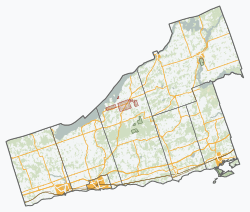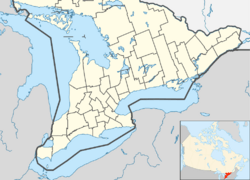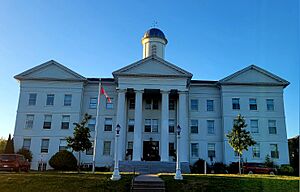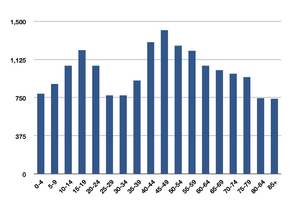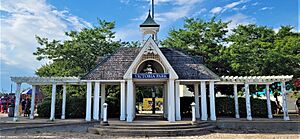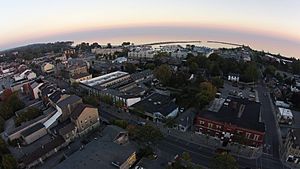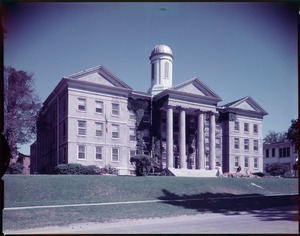Cobourg facts for kids
Quick facts for kids
Cobourg
|
|
|---|---|
| Town of Cobourg | |
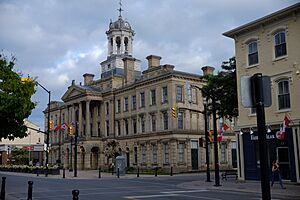
|
|
| Nicknames:
Ontario's Feel Good Town
|
|
| Motto(s):
Our Strength Is In Our Unanimity
|
|
| Country | Canada |
| Province | Ontario |
| County | Northumberland |
| Settled | 1798 |
| Incorporated | 1837 (town) |
| Area | |
| • Land | 22.41 km2 (8.65 sq mi) |
| Population
(2021)
|
|
| • Total | 20,519 |
| • Density | 915.7/km2 (2,372/sq mi) |
| Time zone | UTC−5 (EST) |
| • Summer (DST) | UTC−4 (EDT) |
| Postal Code FSA |
K9A
|
| Area code(s) | 905, 289, 365, 742 |
| Highways | |
| GNBC Code | FARXE |
Cobourg is a town in the Canadian province of Ontario. It is located in Southern Ontario, about 95 kilometers (59 miles) east of Toronto. Cobourg is the biggest town in and the main center of Northumberland County. Its closest neighbor is Port Hope, which is 7 kilometers (4.3 miles) to the west. The town is found along Highway 401 and borders Lake Ontario to the south.
| Top - 0-9 A B C D E F G H I J K L M N O P Q R S T U V W X Y Z |
History of Cobourg
The land where Cobourg is today was once home to the Mississauga people. The first settlements that became Cobourg were started in 1798. These settlers were United Empire Loyalists, people who stayed loyal to Britain during the American Revolution. The town was first a group of smaller villages, later called Hamilton. In 1819, it was renamed Cobourg. This was to honor the marriage of Princess Charlotte Augusta of Wales to Prince Leopold of Saxe-Coburg-Saalfeld.
By the 1830s, Cobourg became an important regional center. This was mainly because of its good harbor on Lake Ontario. In 1835, the Upper Canada Academy was started here. On July 1, 1837, Cobourg officially became a town. The Upper Canada Academy later changed its name to Victoria College. It stayed in Cobourg until 1892, when it moved to Toronto.
The Railway to Rice Lake
Cobourg needed a way to bring goods from inland areas to its harbor. The town decided to build a railway to Rice Lake and further north to Peterborough. This would help transport valuable timber and other resources.
In 1852, people in Cobourg were very excited about the railway. The plan grew to include a 4-kilometer (2.5-mile) bridge across Rice Lake. This bridge would take the railway all the way to Peterborough. By 1854, the tracks reached the lake shore. The railway was used to carry passengers and a lot of lumber from Rice Lake to Cobourg.
However, building the bridge was very difficult. It used many wooden supports and a special swing bridge for boats. The bridge opened in December 1854. But just three days later, it collapsed because of ice moving in the lake. Funds were hard to get to fix it properly.
Another problem was that Port Hope, a nearby town, built its own railway to Peterborough. This new line went around the lake, competing directly with Cobourg's railway. In 1861, the Cobourg bridge was destroyed again by ice and was never repaired. The railway then only connected Cobourg harbor with Harwood, on Rice Lake.
In 1865, the railway was bought by a group of steel makers. They used it to transport iron ore from quarries north of Rice Lake. The ore came by barges across Rice Lake to the railway at Harwood. From there, it was brought to Cobourg Harbour. It was then shipped across Lake Ontario to steel mills in America. This brought steady income to the railway and the town until 1878.
Crossen Car Works
When the iron ore business started, a local company called James Crossen's foundry began making wheels and frames for railway cars. James Crossen realized he could use local timber and his iron products to build entire railway cars. His company, the Crossen Car Manufacturing Company, became the largest builder of wooden railway cars in Canada. They made everything from coal wagons to fancy passenger cars. However, by 1910, steel cars became popular, and the company closed in 1915.
Wealthy Americans Visit Cobourg
The railway and trade brought many rich Americans to Cobourg. It became a popular summer vacation spot. Fancy hotels were built, and wealthy Americans built huge summer homes. Some of these homes still stand today. A ferry service also connected Cobourg to Rochester, New York from 1907 to 1952. This made it even easier for Americans to visit the town.
Victoria Hall: A Grand Building
In 1856, Cobourg was feeling good about its future. The town decided to build a new Town Hall. This grand building, called Victoria Hall, is still the town hall today. It also houses the Art Gallery of Northumberland and the Cobourg Concert Hall. Victoria Hall was designed by architect Kivas Tully. It is famous for its beautiful stone work. The building was officially opened on September 6, 1860, by the Prince of Wales, who later became King Edward VII. At that time, some people in Cobourg even thought the town could become the capital of Canada!
Sifton-Cook Heritage Centre
One of the oldest buildings in Cobourg is now the Sifton-Cook Heritage Centre. It was built in the early 1800s. Over the years, it was used for different industrial purposes and storage. In 2000, the Cobourg Museum Foundation bought and restored it. Now, it is open to visitors to learn about the town's history.
Cobourg Jail: From Prison to Inn
In 1906, the Cobourg Jail opened on Albert Street. It was also called The County Jail. Over time, it grew to hold more and more inmates. In 1998, the jail closed. The next year, it was bought by private owners. The old jail has now been turned into a tourist attraction called the King George Inn. You can still see the jail cells, and some people even stay in them! There is also a family restaurant for guests.
Emergency Landing in 1951
On December 20, 1951, Cobourg made headlines. A chartered airplane, heading for New Jersey, had to make an emergency landing. It landed in a farmer's field near Highway 2. The pilot had lost his way and radio contact. All 44 passengers and three crew members were safe, though very cold. The plane landed in deep snow, which helped it. It was later repaired and able to fly again.
Waterfront Renewal
In the late 1980s and early 1990s, Cobourg worked hard to improve its waterfront. They bought land along the water and made the area more beautiful. A boardwalk was built to connect the harbor and the large sandy beach. More paths were created around Victoria Park and the historic downtown. Because of these improvements, many community events now happen in these areas.
Climate in Cobourg
Cobourg has a climate with warm summers and cold winters. The weather changes a lot throughout the year.
| Climate data for Cobourg STP (1981−2010) | |||||||||||||
|---|---|---|---|---|---|---|---|---|---|---|---|---|---|
| Month | Jan | Feb | Mar | Apr | May | Jun | Jul | Aug | Sep | Oct | Nov | Dec | Year |
| Record high °C (°F) | 13.0 (55.4) |
13.0 (55.4) |
20.0 (68.0) |
26.0 (78.8) |
29.0 (84.2) |
31.5 (88.7) |
36.0 (96.8) |
34.0 (93.2) |
30.0 (86.0) |
24.0 (75.2) |
18.0 (64.4) |
15.5 (59.9) |
36.0 (96.8) |
| Mean daily maximum °C (°F) | −1.4 (29.5) |
0.0 (32.0) |
3.7 (38.7) |
10.3 (50.5) |
16.4 (61.5) |
21.6 (70.9) |
24.6 (76.3) |
24.0 (75.2) |
19.9 (67.8) |
13.1 (55.6) |
7.3 (45.1) |
1.9 (35.4) |
11.8 (53.2) |
| Daily mean °C (°F) | −5.6 (21.9) |
−4.3 (24.3) |
−0.5 (31.1) |
5.9 (42.6) |
11.7 (53.1) |
16.9 (62.4) |
19.9 (67.8) |
19.4 (66.9) |
15.4 (59.7) |
9.0 (48.2) |
3.7 (38.7) |
−2 (28) |
7.5 (45.5) |
| Mean daily minimum °C (°F) | −9.7 (14.5) |
−8.5 (16.7) |
−4.6 (23.7) |
1.5 (34.7) |
6.9 (44.4) |
12.1 (53.8) |
15.2 (59.4) |
14.9 (58.8) |
10.8 (51.4) |
4.8 (40.6) |
0.1 (32.2) |
−5.8 (21.6) |
3.1 (37.6) |
| Record low °C (°F) | −39.0 (−38.2) |
−27.8 (−18.0) |
−26.0 (−14.8) |
−12.0 (10.4) |
−5.0 (23.0) |
−1.0 (30.2) |
5.0 (41.0) |
1.0 (33.8) |
−5.0 (23.0) |
−10.0 (14.0) |
−16.0 (3.2) |
−29.0 (−20.2) |
−39.0 (−38.2) |
| Average precipitation mm (inches) | 66.7 (2.63) |
54.1 (2.13) |
56.8 (2.24) |
76.2 (3.00) |
81.2 (3.20) |
80.5 (3.17) |
64.8 (2.55) |
71.7 (2.82) |
93.2 (3.67) |
76.3 (3.00) |
93.2 (3.67) |
75.8 (2.98) |
890.4 (35.06) |
| Average rainfall mm (inches) | 34.0 (1.34) |
32.9 (1.30) |
42.7 (1.68) |
74.3 (2.93) |
81.2 (3.20) |
80.5 (3.17) |
64.8 (2.55) |
71.7 (2.82) |
93.2 (3.67) |
76.3 (3.00) |
89.2 (3.51) |
53.1 (2.09) |
793.9 (31.26) |
| Average snowfall cm (inches) | 32.7 (12.9) |
21.2 (8.3) |
14.2 (5.6) |
1.8 (0.7) |
0.0 (0.0) |
0.0 (0.0) |
0.0 (0.0) |
0.0 (0.0) |
0.0 (0.0) |
0.0 (0.0) |
4.0 (1.6) |
22.7 (8.9) |
96.5 (38.0) |
| Average precipitation days (≥ 0.2 mm) | 11.2 | 8.3 | 9.3 | 11.2 | 10.9 | 9.8 | 8.5 | 10.0 | 10.0 | 11.6 | 12.1 | 10.8 | 123.6 |
| Average rainy days (≥ 0.2 mm) | 4.6 | 4.2 | 6.5 | 10.7 | 10.9 | 9.8 | 8.5 | 10.0 | 10.0 | 11.6 | 11.3 | 6.6 | 104.8 |
| Average snowy days (≥ 0.2 cm) | 7.0 | 4.6 | 3.4 | 0.65 | 0.0 | 0.0 | 0.0 | 0.0 | 0.0 | 0.0 | 0.92 | 4.6 | 21.2 |
| Source: Environment Canada | |||||||||||||
Getting Around Cobourg
Highway 401 and Northumberland County Road 2 (which used to be Highway 2) go through Cobourg. County Road 45 starts in Cobourg and heads north-east.
Major railway lines for Canadian Pacific and Canadian National also pass through the town. Via Rail offers passenger train service at the Cobourg railway station. You can take a train from here to Toronto, Ottawa, or Montreal.
Cobourg Transit is the local bus system. It provides daily bus service around the town. The buses stop running by 7 PM, which can make it hard for some people to travel later in the evening.
The Ontario Waterfront Trail also goes through Cobourg. Many cyclists use this trail during the warmer months.
Cobourg's Population
| Historical populations | ||
|---|---|---|
| Year | Pop. | ±% |
| 1841 | 3,347 | — |
| 1871 | 4,442 | +32.7% |
| 1881 | 4,957 | +11.6% |
| 1891 | 4,829 | −2.6% |
| 1901 | 4,239 | −12.2% |
| 1911 | 5,074 | +19.7% |
| 1921 | 5,327 | +5.0% |
| 1931 | 5,834 | +9.5% |
| 1941 | 5,907 | +1.3% |
| 1951 | 7,470 | +26.5% |
| 1961 | 10,646 | +42.5% |
| 1971 | 11,282 | +6.0% |
| 1981 | 11,385 | +0.9% |
| 1991 | 15,079 | +32.4% |
| 1996 | 16,185 | +7.3% |
| 2001 | 17,172 | +6.1% |
| 2006 | 18,210 | +6.0% |
| 2011 | 18,519 | +1.7% |
| 2016 | 19,440 | +5.0% |
| 2021 | 20,519 | +5.6% |
In 2021, Cobourg had a population of 20,519 people. This was a 5.6% increase from its population in 2016. The town covers a land area of 22.41 square kilometers (8.65 square miles). This means there were about 915.7 people living in each square kilometer in 2021.
Age Profile
- Age 0-14: 18.1%
- Age 15-24: 11.9%
- Age 25-44: 24.7%
- Age 45-64: 24.2%
- Age 65-74: 10.8%
- Age 75+: 10.3%
Religious Make Up
- 56.1% Protestant
- 23.9% Catholic
- 2.2% other Christian
- 0.7% other religions
- 17.1% no religion
Racial Profile
- 91.4% White
- 4.4% Aboriginal
- 3.8% Korean
- 0.7% Black
Education in Cobourg
Public schools in Cobourg are managed by the Kawartha Pine Ridge District School Board. Catholic schools are managed by the Peterborough Victoria Northumberland and Clarington Catholic District School Board.
Cobourg also has a smaller campus of Fleming College.
In 1871, Cobourg's first high school, the Collegiate Institute, was built. By 1899, it was too small. A new school was built on the west side of King Street. This new school was called the West high school, and the older one became the East high school. Both schools existed for 116 years. In 2015, they both closed. A brand new Cobourg Collegiate Institute was built on the old East high school property. The old West high school was not torn down. It is now a private school for grades 7-12 called William Academy Cobourg West.
Schools in Cobourg
Things to See and Do in Cobourg
Cobourg has kept its small-town feel. The downtown area and nearby homes are part of a special Heritage Conservation District. This means they are protected to keep their historic look. Victoria Hall, the town hall built in 1860, is a National Historic Site of Canada. The oldest building in town is now the Sifton Cook Heritage Centre. It is run by the Cobourg Museum Foundation.
Cobourg has several parks. The Cobourg Waterfront Festival is an annual arts and crafts event. It takes place in Victoria Park, on the beach, and at the harbor around Canada Day. Cobourg's oldest yearly event is the Cobourg Highland Games. It started in 1963 to celebrate Scottish culture. This event is now held in Victoria Park in June.
Cobourg's beach, Victoria Park Beach, is a popular spot. It is used for volleyball, events, and family picnics. The beach has a splash park, a playground, and places to eat. There is also a small trailer park right next to the beach. Lifeguards are on duty some days, and it is safe to swim. Close to downtown, visitors can shop in local stores and eat at many restaurants.
Cobourg is also home to the Port Hope Drive-In, which is Canada's oldest drive-in movie theater.
Media in Cobourg
- Northumberland Today is a daily newspaper. It includes news from the Cobourg Star and Port Hope Guide.
Radio
Five radio stations broadcast from Cobourg. They offer music, news, and local programs for Northumberland County.
- FM 89.7 - CFWN: A community radio station run by volunteers.
- FM 90.7 - CHJJ: Plays Christian music.
- FM 93.3 - CKSG: Plays adult contemporary music.
- FM 103.1 - CFMZ: Plays classical music.
- FM 107.9 - CHUC: Plays classic hits.
TV
Cobourg uses cable 10 to show local events and weather. There are no local TV stations that broadcast over the air. The closest one is CHEX-TV in Peterborough, Ontario.
Famous People from Cobourg
Many notable people have connections to Cobourg:
- Ada Blenkhorn: A hymn writer who wrote "Keep on the Sunny Side".
- Jeremiah Brown: Won a silver medal in rowing at the 2012 London Olympic Games.
- Mandy Bujold: A Canadian boxer.
- James Cockburn: A lawyer and one of the Fathers of Confederation.
- Marie Dressler: A famous silent film actress who won an Academy Award in 1931.
- Sandford Fleming: Helped create the idea of time zones.
- Rev. John Weir Foote: A politician, chaplain, and winner of the Victoria Cross.
- Ed Greenwood: Author of the Forgotten Realms setting for Dungeons & Dragons.
- Paul Kane: An Irish-born Canadian painter.
- John Murray: A pioneering oceanographer, often called the father of modern oceanography.
- Josh Richards: An internet personality, musician, and actor.
- Steve Smith: An NHL hockey player.
- Justin Williams: An NHL hockey player who won the Stanley Cup three times.
Sister City
Cobourg is twinned with:
 Coburg, Germany
Coburg, Germany


